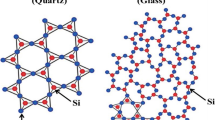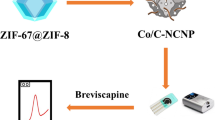Abstract
Monodispersed Au nanoparticles in ordered mesoporous carbon/silica (Au/OMCS) nanocomposites were prepared by the solvent evaporation induced self-assembly. Au/OMCS nanocomposites were characterized through XRD, BET, and TEM. The obtained nanocomposites exhibit uniform mesopores with the size of 18 ± 2 nm. And ultrafine Au nanoparticles with the size of 3~7 nm are well dispersed in the cavities. An ultrasensitive nanoenzyme sensor was fabricated based on a Au/OMCS-modified electrode. The Au/OMCS-modified electrode displays high xanthine oxidase–like catalytic activity evaluated through cyclic voltammetry (CV) and differential pulse voltammetry (DPV). The DPV response currents are linearly dependent on concentrations of xanthine (Xa) in the range 0.10–20 μM, along with a high sensitivity of 6.84 μA μM−1 cm−2 and very low detection limit of 0.006 μM (S/N = 3) under the optimal working potential of 0.64 V vs. SCE. Interference experiments show that the nanoenzyme sensor has no obvious responses to most potentially interfering species at a potential of 0.64 V. The fabricated sensor has been applied to the determination of Xa in spiked urine samples with recoveries ranging from 98.26 to 101.4%.

Graphical abstract








Similar content being viewed by others

References
José RJ, José M, Maria D (2007) On-line automatic SPE-CE coupling for the determination of biological markers in urine. Electrophoresis 28:789–798. https://doi.org/10.1002/elps.200600340
Christopher LR, Laura MM, Suzanne B, Demetrius E et al (2007) Acute renal failure from xanthine nephropathy during management of acute leukemia. Pediatr Nephrol 22:132–135. https://doi.org/10.1007/s00467-006-0287-z
Dervisevic M, Dervisevic E, Senel M (2019) Recent progress in nanomaterial-based electrochemical and optical sensors for hypoxanthine and xanthine. A review. Microchim Acta 186:749. https://doi.org/10.1007/s00604-019-3842-6
Cooper N, Khosravan R, Erdmann C, Fiene J, Lee JW (2006) Quantification of uric acid, xanthine and hypoxanthine in human serum by HPLC for pharmacodynamic studies. J Chromatogr B 837:1–10
Kant R, Tabassum R, Gupta BD (2018) Xanthine oxidase functionalized Ta2O5 nanostructures as a novel scaffold for highly sensitive SPR based fiber optic xanthine sensor. Biosens Bioelectron 99:637–645. https://doi.org/10.1016/j.bios.2017.08.040
Dalkıran B, Erden PE, Kılıç E (2017) Amperometric biosensors based on carboxylated multiwalled carbon nanotubes-metal oxide nanoparticles-7,7,8,8-tetracyanoquinodimethane composite for the determination of xanthine. Talanta 167:286–295. https://doi.org/10.1016/j.talanta.2017.02.021
Wang ZP, Ma BK, Shen C, Lai OM., Tan CP, Cheong LZ (2019) Electrochemical biosensing of chilled seafood freshness by xanthine oxidase immobilized on copper-based metal–organic framework nanofiber film. Food Anal Methods 12(2019) 1715–1724. https://doi.org/10.1007/s12161-019-01513-8
Gao LZ, Yan XY (2016) Nanozymes: an emerging field bridging nanotechnology and biology. Sci China Life Sci 59:400–402. https://doi.org/10.1007/s11427-016-5044-3
Nasir M, Nawaz MH, Latif U, Yaqub M, Hayat A, Rahim A (2017) An overview on enzyme-mimicking nanomaterials for use in electrochemical and optical assays. Microchim Acta 184:323–342. https://doi.org/10.1007/s00604-016-2036-8
Gao L, Zhuang J, Nie L, Zhang JB, Zhang Y, Gu N, Wang TH, Feng J, Yang DL, Perrett S, Yan XY (2007) Intrinsic peroxidase-like activity of ferromagnetic nanoparticles. Nat Nanotechnol 2:577–583. https://doi.org/10.1038/nnano.2007.260
Yin JF, Cao HQ, Lu YX (2012) Self-assembly into magnetic Co3O4 complex nanostructures as peroxidase. J Mater Chem 22:527–534. https://doi.org/10.1039/c1jm14253d
Zhu AP, Sun K, Petty HR (2012) Titanium doping reduces superoxide dismutase activity, but not oxidase activity, of catalytic CeO2 nanoparticles. Inorg Chem Commun 15:235–237. https://doi.org/10.1016/j.inoche.2011.10.034
Zheng XX, Liu Q, Jing C, Li Y, Li D, Luo WJ, Wen YQ, He Y, Huang Q, Long YT (2011) Catalytic gold nanoparticles for nanoplasmonic detection of DNA hybridization. Angew Chem Int Ed 50:11994–11998. https://doi.org/10.1002/anie.201105121
Zhang L, Li SB, Xin JJ, Ma HY, Pang HJ, Tan LC, Wang XM (2019) A non-enzymatic voltammetric xanthine sensor based on the use of platinum nanoparticles loaded with a metal-organic framework of type MIL-101(Cr). Application to simultaneous detection of dopamine, uric acid, xanthine and hypoxanthine. Microchim Acta 186:9. https://doi.org/10.1007/s00604-018-3128-4
Chen Y, Zhang XF, Wang AJ, Zhang QL, Huang H, Feng JJ (2019) Ultrafine Fe3C nanoparticles embedded in N-doped graphitic carbon sheets for simultaneous determination of ascorbic acid, dopamine, uric acid and xanthine. Microchim Acta 186:660. https://doi.org/10.1007/s00604-019-3769-y
Hu LZ, Yuan YL, Zhang L, Zhao JM, Majeed S, Xu GB (2013) Copper nanoclusters as peroxidase mimetics and their applications to H2O2 and glucose detection. Anal Chim Acta 762:83–86. https://doi.org/10.1016/j.aca.2012.11.056
Rahim A, Santos LS, Barros S, Kubota LT, Landers R, Gushikem Y (2014) Electrochemical detection of nitrite in meat and water samples using a mesoporous carbon ceramic SiO2/C electrode modified with in situ generated manganese(II) phthalocyanine. Electroanalysis 26:541–547. https://doi.org/10.1002/elan.201300468
Rahim A, Santos LS, Barros SB, Kubota LT, Gushikem Y (2013) Dissolved O2 sensor based on cobalt(II) phthalocyanine immobilized in situ on electrically conducting carbon ceramic mesoporous SiO2/C material. Sensors Actuators B Chem 177:231–238. https://doi.org/10.1016/j.snb.2012.10.110
Barros SB, Rahim A, Tanaka AA, Arenas LT, Landers R, Gushikem Y (2013) In situ immobilization of nickel(II) phthalocyanine on mesoporous SiO2/C carbon ceramic matrices prepared by the sol–gel method: use in the simultaneous voltammetric determination of ascorbic acid and dopamine. Electrochim Acta 87:140–147. https://doi.org/10.1016/j.electacta.2012.09.012
Liu QY, Ding YY, Yang YT, Zhang LY, Sun LF, Chen P, Gao C (2016) Enhanced peroxidase-like activity of porphyrin functionalized ceria nanorods for sensitive and selective colorimetric detection of glucose. Mater Sci Eng C 59:445–453. https://doi.org/10.1016/j.msec.2015.10.046
Wei H, Wang E (2013) Nanomaterials with enzyme-like characteristics (nanozymes): next-generation artificial enzymes. Chem Soc Rev 42:6060–6093. https://doi.org/10.1039/c3cs35486e
Çiftçi H, Tamer U (2012) Functional gold nanorod particles on conducting polymer poly (3-octylthiophene) as non-enzymatic glucose sensor. React Funct Polym 72:127–132
Xu Q, Yuan H, Dong XL, Zhang Y, Asif M, Dong Z, He W, Ren J, Sun Y, Xiao F (2018) Dual nanoenzyme modified microelectrode based on carbon fiber coated with AuPd alloy nanoparticles decorated graphene quantum dots assembly for electrochemical detection in clinic cancer samples. Biosens Bioelectron 107:153–162. https://doi.org/10.1016/j.bios.2018.02.026
Thanh TD, Balamurugan J, Lee SH, Kim NH, Lee JH (2016) Novel porous gold-palladium nanoalloy network-supported graphene as an advanced catalyst for non-enzymatic hydrogen peroxide sensing. Biosens Bioelectron 85:669–678. https://doi.org/10.1016/j.bios.2016.05.075
Wang S, Zhao QF, Wei HM, Wang JQ, Cho MY, Cho HS, Terasaki O, Wan Y (2013) Aggregation-free gold nanoparticles in ordered mesoporous carbons: toward highly active and stable heterogeneous catalysts. J Am Chem Soc 135:11849–11860. https://doi.org/10.1021/ja403822d
Yu K, Smarsly B, Brinker CJ (2003) Self-assembly and characterization of mesostructured silica films with a 3D arrangement of isolated spherical mesopores. Adv Funct Mater 13:47–52
Liu RL, Shi YF, Wan Y, Meng Y, Zhang FQ, Gu D, Chen Z, Tu B, Zhao D (2006) Triconstituent co-assembly to ordered mesostructured polymer−silica and carbon−silica Nanocomposites and large-pore Mesoporous carbons with high surface areas. J Am Chem Soc 128:11652–11662. https://doi.org/10.1021/ja0633518
Zhang JY, Deng YH, Wei J, Sun ZK, Gu D, Bongard H, Liu C, Wu H, Tu B, Schüth F, Zhao D (2009) Design of amphiphilic ABC triblock copolymer for templating synthesis of large-pore ordered mesoporous carbons with tunable pore wall thickness. Chem Mater 21:3996–4005. https://doi.org/10.1021/cm901371r
Zhu D, Ma HY, Pang HJ, Tan LC, Jiao J, Chen T (2018) Facile fabrication of a non-enzymatic nanocomposite of heteropolyacids and CeO2@Pt alloy nanoparticles doped reduced graphene oxide and its application towards the simultaneous determination of xanthine and uric acid. Electrochim Acta 266:54–65. https://doi.org/10.1016/j.electacta.2018.01.185
Zhang FY, Wang ZH, Zhang YZ, Zheng ZX, Wang C, Du YL, Ye WC (2012) Simultaneous electrochemical determination of uric acid, xanthine and hypoxanthine based on poly(l-arginine)/graphene composite film modified electrode. Talanta 93:320–325. https://doi.org/10.1016/j.talanta.2012.02.041
Ko JA, Lim HB (2012) Fluorescence quenching of dye-doped core-shell nanoparticles by metal ions. Anal Methods 4:2009–2012. https://doi.org/10.1039/c2ay25036e
Wang Y, Tong LL (2010) Electrochemical sensor for simultaneous determination of uric acid, xanthine and hypoxanthine based on poly (bromocresol purple) modified glassy carbon electrode. Sensors Actuators B Chem 150:43–49. https://doi.org/10.1016/j.snb.2010.07.044
Ojani R, Alinezhad A, Abedi Z (2013) A highly sensitive electrochemical sensor for simultaneous detection of uric acid, xanthine and hypoxanthine based on poly(L-methionine) modified glassy carbon electrode. Sensors Actuators B Chem 188:621–630. https://doi.org/10.1016/j.snb.2013.07.015
Wen Y, Xu J, Liu M, Li D, Lu L, Yue R, He H (2012) A vitamin C electrochemical biosensor based on one-step immobilization of ascorbate oxidase in the biocompatible conducting poly(3,4-ethylenedioxythiophene)-lauroylsarcosinate film for agricultural application in crops. J Electroanal Chem 674:71–82. https://doi.org/10.1016/j.jelechem.2012.03.021
Funding
The authors received supports from the Key Research and Development Plan of Ministry of Science and Technology of China (No. 2017YFB0102902).
Author information
Authors and Affiliations
Corresponding authors
Ethics declarations
Conflict of interest
The authors declare that they have no competing interests.
Additional information
Publisher’s note
Springer Nature remains neutral with regard to jurisdictional claims in published maps and institutional affiliations.
Electronic supplementary material
ESM 1
(DOCX 254 kb)
Rights and permissions
About this article
Cite this article
Wang, Y., Zhao, H., Song, H. et al. Monodispersed gold nanoparticles entrapped in ordered mesoporous carbon/silica nanocomposites as xanthine oxidase mimic for electrochemical sensing of xanthine. Microchim Acta 187, 543 (2020). https://doi.org/10.1007/s00604-020-04494-2
Received:
Accepted:
Published:
DOI: https://doi.org/10.1007/s00604-020-04494-2



